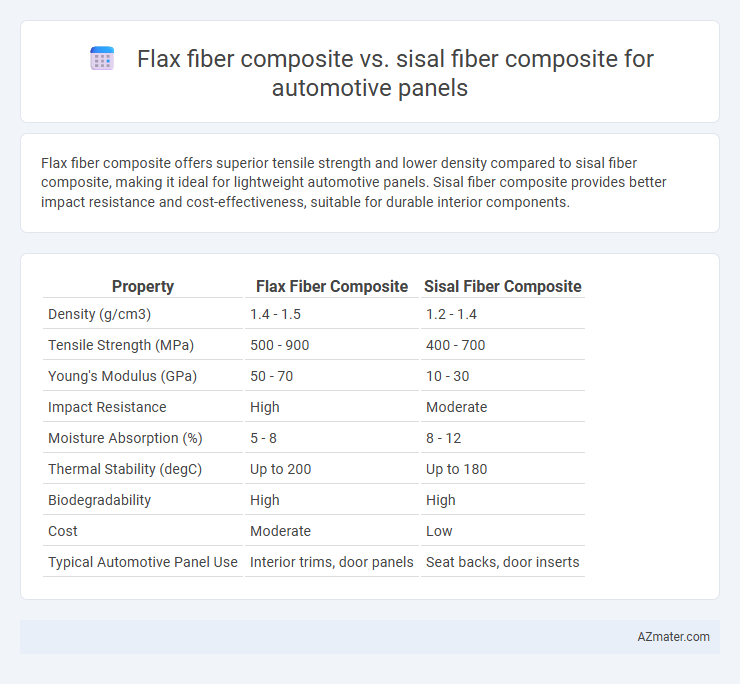Flax fiber composite offers superior tensile strength and lower density compared to sisal fiber composite, making it ideal for lightweight automotive panels. Sisal fiber composite provides better impact resistance and cost-effectiveness, suitable for durable interior components.
Table of Comparison
| Property | Flax Fiber Composite | Sisal Fiber Composite |
|---|---|---|
| Density (g/cm3) | 1.4 - 1.5 | 1.2 - 1.4 |
| Tensile Strength (MPa) | 500 - 900 | 400 - 700 |
| Young's Modulus (GPa) | 50 - 70 | 10 - 30 |
| Impact Resistance | High | Moderate |
| Moisture Absorption (%) | 5 - 8 | 8 - 12 |
| Thermal Stability (degC) | Up to 200 | Up to 180 |
| Biodegradability | High | High |
| Cost | Moderate | Low |
| Typical Automotive Panel Use | Interior trims, door panels | Seat backs, door inserts |
Introduction to Natural Fiber Composites in Automotive Panels
Natural fiber composites such as flax fiber composite and sisal fiber composite are increasingly used in automotive panels due to their lightweight, high strength-to-weight ratio, and sustainability benefits. Flax fibers offer superior tensile strength and stiffness compared to sisal fibers, making them preferable for structural components requiring higher mechanical performance. Sisal fiber composites provide cost-effective solutions with good impact resistance and energy absorption, suitable for non-structural interior panels, emphasizing the balance between performance and eco-friendly materials in automotive manufacturing.
Overview of Flax Fiber Composites
Flax fiber composites exhibit high specific strength and stiffness, making them a sustainable alternative to synthetic fibers in automotive panels. Their low density and notable impact resistance contribute to lightweight vehicle designs while maintaining safety standards. Flax fibers also offer excellent vibration damping and biodegradability, enhancing the eco-friendly profile of automotive components.
Overview of Sisal Fiber Composites
Sisal fiber composites, derived from the Agave sisalana plant, offer enhanced biodegradability, excellent tensile strength, and good impact resistance, making them suitable for automotive panel applications. These natural fibers exhibit superior moisture absorption compared to flax fibers, which can be mitigated through chemical treatments or hybridization in composite manufacturing. Sisal composites contribute to lightweight vehicle design, improving fuel efficiency while maintaining cost-effectiveness and environmental sustainability in automotive parts production.
Mechanical Properties: Flax vs Sisal Fiber Composites
Flax fiber composites exhibit higher tensile strength and modulus compared to sisal fiber composites, making them more suitable for automotive panels requiring superior mechanical performance. Sisal fibers offer better impact resistance and toughness, beneficial for components subjected to dynamic loads. Both materials provide lightweight alternatives to traditional composites, but flax fibers generally deliver enhanced stiffness and strength, which are critical for structural applications in automotive panel manufacturing.
Weight and Density Comparison
Flax fiber composite exhibits a lower density of approximately 1.3 g/cm3 compared to sisal fiber composite, which typically ranges around 1.4 to 1.5 g/cm3, making flax composites lighter for automotive panel applications. The reduced weight of flax fiber composites contributes to enhanced fuel efficiency and improved vehicle performance due to decreased overall mass. In terms of density, flax fibers provide an optimal balance of mechanical properties while minimizing weight, offering a competitive advantage over sisal fiber composites in lightweight automotive panel manufacturing.
Environmental Impact and Sustainability
Flax fiber composites exhibit superior environmental benefits for automotive panels due to their biodegradability and lower carbon footprint compared to synthetic fibers, while sisal fiber composites also provide renewable sourcing but often involve more water-intensive cultivation. Both fibers reduce reliance on petroleum-based materials by offering lightweight, recyclable alternatives that contribute to improved vehicle fuel efficiency. The sustainable cultivation and processing of flax result in less environmental degradation, making flax fiber composites a more eco-friendly choice in automotive applications.
Cost-Effectiveness for Automotive Applications
Flax fiber composites offer superior cost-effectiveness for automotive panels due to their lower raw material cost and higher mechanical performance compared to sisal fiber composites, resulting in reduced overall production expenses. Flax fibers provide better tensile strength and durability, which enhances longevity and reduces maintenance costs, making them a more economical choice for automotive manufacturers. Sisal fiber composites, while cheaper initially, often require additional treatments to meet automotive standards, increasing processing costs and diminishing their cost-effectiveness.
Processing Techniques and Compatibility with Polymers
Flax fiber composites exhibit superior compatibility with thermoset and thermoplastic polymers due to their fine fiber structure, allowing easier wetting and resin impregnation through techniques like resin transfer molding (RTM) and compression molding. Sisal fiber composites, while coarser, benefit from alkali and silane treatments to enhance fiber-matrix adhesion, commonly processed via hand lay-up and injection molding methods suitable for automotive panels. The inherent variability and surface roughness of sisal require optimized processing parameters to achieve comparable mechanical performance to flax composites in automotive applications.
Durability, Moisture Resistance, and Longevity
Flax fiber composites exhibit higher durability and better mechanical strength compared to sisal fiber composites, making them more suitable for automotive panel applications requiring structural integrity. Sisal fiber composites show lower moisture absorption rates, enhancing their moisture resistance and reducing the risk of swelling or degradation in humid conditions. Flax fiber composites generally offer greater longevity due to superior resistance to environmental aging and mechanical wear, ensuring longer service life in automotive panels.
Conclusion: Optimal Choice for Automotive Panel Manufacturing
Flax fiber composites outperform sisal fiber composites for automotive panel manufacturing due to their superior mechanical strength, lower density, and enhanced vibration damping properties, leading to improved vehicle performance and fuel efficiency. They also exhibit better environmental sustainability with higher biodegradability and lower carbon footprint during production. These factors make flax fiber composites the optimal choice for lightweight, eco-friendly, and durable automotive panels.

Infographic: Flax fiber composite vs Sisal fiber composite for Automotive panel
 azmater.com
azmater.com